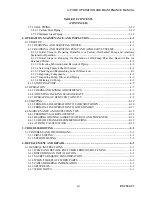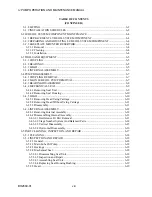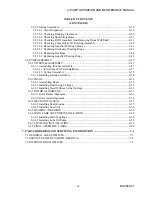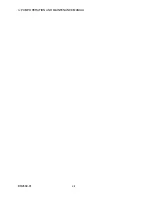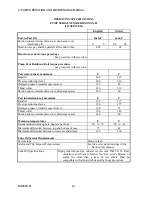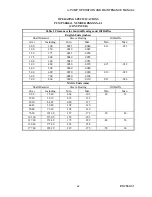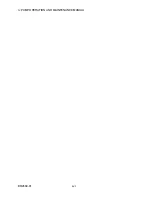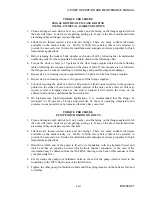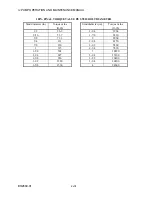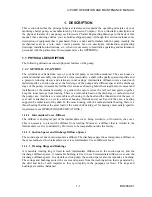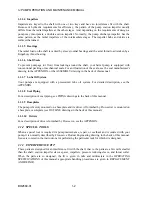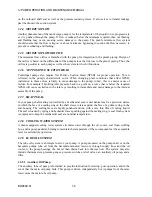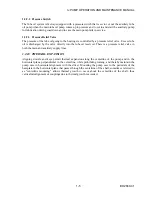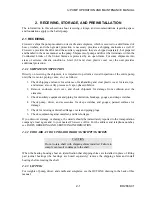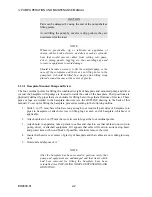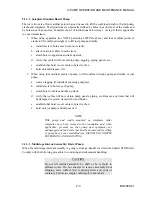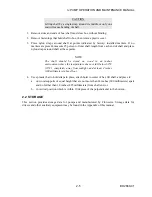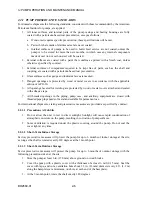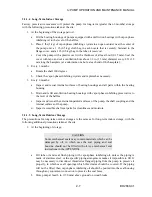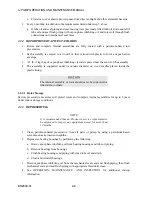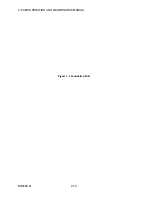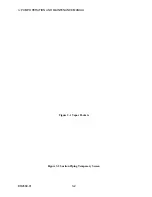
IJ PUMP OPERATION AND MAINTENANCE MANUAL
1-3
BO2660-01
1.2 OPERATING PRINCIPLES
The following discussions are focused on the principles that underlie the operation of your pump.
Where figures are not included with the text, see the PUMP ASSEMBLY drawing and schematics in
the back of this manual, which also provide pictorial support of the text.
1.2.1 PUMP FLOW
Since the impellers in your pump are in series and all face in the same direction, the flow of liquid
through the pump is in one direction, through each stage in turn. Pressure is added at each stage and
the pressure at the last stage is the discharge pressure for which the pump is designed.
Liquid enters the suction impeller through the inlet at the center. The rotation of the impeller imparts
energy to the liquid causing it to be thrown outward at high velocity into the multi-vane diffuser
surrounding the impeller. The energy in the liquid as it leaves the impeller appears as velocity head
which is converted into pressure head in the diffuser passages. Leaving the diffuser, the liquid enters
the intermediate cover where it is directed into the inlet of the next impeller. The flow follows this
same sequence from the first to the last stage. The liquid from the discharge diffuser enters the pump
case, then leaves through the discharge nozzle in the case.
1.2.2 BALANCE
In a multi-stage, high pressure pump, radial and axial balance is a requirement for satisfactory
operation. Unbalanced radial forces cause excessive vibration, unnecessary wear, and noise.
Unbalanced axial forces must be controlled to prevent damage to bearings and to the internal parts of
the pump.
1.2.2.1 Radial Balance
Two separate radial forces must be balanced, one dynamic, the other hydraulic.
Dynamic unbalance is caused by variations in the distribution of weight in castings for impellers. The
impellers in your pump have been balanced at the factory in special dynamic balance machines.
Radial hydraulic unbalance is caused by unequal pressure in the liquid around the periphery of the
impellers. This will create a radial thrust which, if not balanced, will cause serious shaft deflection.
Radial hydraulic balance is obtained with diffusers fitted with equally spaced multiple vanes. Such
diffusers will equalize the pressure at all points about the periphery of the impellers, thereby
eliminating radial thrust and in turn shaft deflection.
1.2.2.2 Axial Balance
In centrifugal pumps where the impellers are in a line, the differential pressure across each impeller
will tend to generate a thrust towards the suction end of the pump. To compensate for this build up of
thrust, your pump incorporates, at the outboard end of the shaft and inside the head, a pressure
reducing sleeve that rotates within a pressure reducing bushing. The clearance between the drum and
the bushing is close, so the drum acts as a piston with its inner face acted on by discharge pressure
and with its outer face open to suction pressure. Thus the resultant force toward the outboard end of
the pump counters the thrust acting toward the inboard end.
1.2.3 BALANCING DRUM PIPING
The pressure reducing sleeve piping affords an unrestricted passage between the area immediately
outboard of the pressure reducing sleeve and the suction end of the pump, serving to reduce pressure
Содержание IJ
Страница 2: ...IJ PUMP INSTALLATION OPERATION MAINTENANCE ...
Страница 3: ......
Страница 5: ...IJ PUMP OPERATION AND MAINTENANCE MANUAL BO2660 01 iv ...
Страница 11: ...IJ PUMP OPERATION AND MAINTENANCE MANUAL BO2660 01 x ...
Страница 13: ...IJ PUMP OPERATION AND MAINTENANCE MANUAL BO2660 01 xii ...
Страница 17: ...IJ PUMP OPERATION AND MAINTENANCE MANUAL BO2660 01 xvi ...
Страница 25: ......
Страница 35: ...IJ PUMP OPERATION AND MAINTENANCE MANUAL BO2660 01 2 10 Figure 2 1 Foundation Bolt ...
Страница 65: ......
Страница 79: ......
Страница 83: ......

